Getting to the roots of sustainability
Getting to the roots of sustainability: Back in April, users of ‘turf Twitter’ bore witness to the effect extreme weather has on the sports turf industry.
A combination of 22 days of ground frost, record levels of sunshine and the fourth driest April on record made the preparing playing surfaces exceptionally challenging. Predictably, May was a washout with relentless heavy rain falling across most of the country.

Getting to the roots of sustainability
Weather extremes add additional pressures and keep sustainability and climate change issues high on the industry’s agenda. The most commonly described approach to sustainability in turfgrass management is a reduction in inputs, such as fertiliser, fungicides and water, but grass breeders at Barenbrug have given turf managers the ability to underpin their sustainability strategy with Sustainable Grass Technology.
The result of years of specialist breeding, significant investment from the global leader in turfgrass seed production, and numerous independent and in-house trials, grasses in SGT blends have been bred to excel in one or more of four key areas of research;
- nitrogen use efficiency to reduce fertiliser use and cost
- drought tolerance to increase survival and reduce the need for irrigation in stress periods
- increased disease tolerance to reduce fungicide use
- lower clippings yield to reduce mowing frequency, labour and fuel consumption
“Our breeders had the foresight to anticipate the industry’s needs. These grasses have, in some instances, been decades in the making,” explained Dr David Greenshields, Barenbrug UK’s Amenity Commercial Manager.
“Our aim is to give turf managers all the desirable characteristics that help them meet the demands of the modern game, with minimal inputs, and for surfaces to retain their health, vibrancy and resilience under extreme conditions, such as drought or heavy wear. For turf managers looking to reduce their inputs and all the associated costs without compromising turf quality, using grasses specifically bred for that purpose and proven through independent testing is the ideal starting point.”
SGT’s breeding objectives led to the development of Barprium, a perennial ryegrass cultivar that has set a new benchmark for nitrogen efficiency.
Trials conducted at the STRI from 2016 to 2018 focused on identifying which perennial ryegrass varieties use lower levels of nitrogen most efficiently to deliver acceptable turf quality.
It compared the performance of seven of Barenbrug’s existing high performing perennial ryegrass cultivars against the new cultivar.
When low levels of nitrogen were applied to all cultivars, all performed to a good standard throughout the trials, but Barprium showed greater quality and coverage, even with a 50% nitrogen input. The other seven cultivars all ranked highly in the BSPB Turfgrass Seed Listings, making Barprium’s performance even more impressive.
Strong summer colour in Barprium has also proved an asset to the blend for low input golf fairways.
“SGT Rye Fairway is a great example of our global breeding and trials resource delivering excellent regional solutions. The fi ne fescue cultivars in the mix were selected for their sustainable performance characteristics,” explained David.
“Hardtop hard fescue and Barjessica strong creeping red fescue performed particularly well in periods of heat and drought.
Data from fi ne fescue performance trials conducted in 2018 showed that turf quality of hard fescue was unrivalled during the intense heat and drought of a memorable summer, and the recovery capacity of Barjessica was exceptional. The selected cultivars also provide excellent resistance to Red Thread – perfect for low nutrition fairways.”
David is urging Course Managers to consider the significant benefits of hard fescue on fairways.
“The summer of 2018 bought into sharp focus the situation turf managers face during lengthy periods without rainfall. Hard fescue has been used successfully on the continent, in the US and in Australia where summers are hotter and drier than ‘typical’ ones in the UK.
“It is the default species where there is no irrigation, which demonstrates its natural drought tolerance. It is also resilient and more nitrogen efficient than red fescue, and modern cultivars produce high quality turf.
“It currently makes up 50% and 20% of our two SGT mixtures, and I believe it will play a greater role in the long-term management of medium-fi ne turf with low maintenance requirements.
For new constructions and full renovations, sustainability starts with sowing the right cultivars. For established turf, overseeding with these new cultivars can enable the sward to adapt over time to provide additional resilience when and where it’s needed most.”























